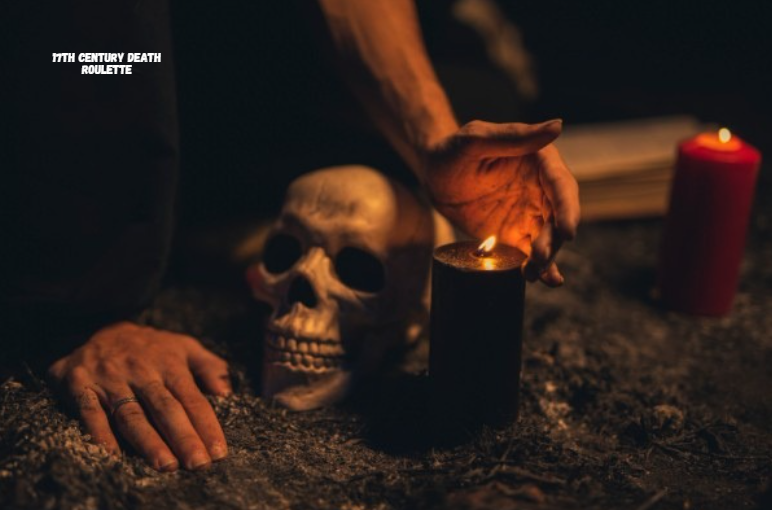The “17th century death roulette” has sparked curiosity due to its unique, dark concept. The game, originally popularized by Matt Round’s Death Roulette, involves the grim reality of death in 17th-century London, where players are randomly assigned a cause of death based on historical records from that era.
While it may seem like a macabre novelty game today, it’s rooted in a period of history when death was an ever-present part of life, and people lived in constant fear of diseases, poor sanitation, and unpredictable accidents. This article will explore the historical context of death in 17th-century London, its connection to the “17th century death roulette,” and what this strange game reveals about society’s attitudes toward mortality.
Contents
- 1 What is 17th Century Death Roulette?
- 2 The Historical Context: Life and Death in 17th Century London
- 3 Matt Round’s Death Roulette: A Digital Exploration of Mortality
- 4 The Deeper Meaning Behind Death Roulette
- 5 Insights and Interpretations: Why 17th Century Death Roulette Resonates Today
- 6 Common Causes of Death in 17th Century Death Roulette
- 7 FAQs About 17th Century Death Roulette
- 8 Conclusion: The Morbid Fascination of 17th Century Death Roulette
What is 17th Century Death Roulette?
The “17th century death roulette” refers to a digital game developed by Matt Round that uses real death records from London in the 1600s to simulate a macabre version of roulette. Players “spin” the wheel, which then randomly selects a recorded cause of death from that time, ranging from plagues to accidents to murders. The idea is to present a stark reminder of how fragile life was in an era with far fewer medical advancements and safety regulations than we have today.
While this game is a quirky and grim reminder of the randomness of death, the actual records it draws from paint a far darker picture of life in 17th-century London, a period marked by plagues, high infant mortality, and poor living conditions.
The Historical Context: Life and Death in 17th Century London
To understand the gravity of the “17th century death roulette,” it is crucial to delve into the actual living conditions of Londoners during that time. The 1600s were tumultuous in England, with the country undergoing significant political, social, and economic changes. London, the capital, was expanding rapidly, and with it came overcrowded living conditions, poor sanitation, and the spread of diseases.
The Bubonic Plague and Other Epidemics
Perhaps the most notorious cause of death in 17th-century London was the bubonic plague, which ravaged the city in 1665 during what is now called The Great Plague of London. This was not the first time Londoners had suffered from the plague; it had been a recurring threat since the 14th century. However, the 1665 outbreak was particularly devastating, killing an estimated 100,000 people—almost a quarter of London’s population at the time.
The nature of the plague was horrifying: it spread quickly, symptoms were gruesome, and death was often swift. Victims would develop painful swellings (buboes) and experience fever, delirium, and vomiting before succumbing to the disease. The randomness of the disease, combined with its high mortality rate, made it a perfect entry for “17th century death roulette.”
Other diseases like smallpox, typhus, and influenza also took a heavy toll during this period, contributing to the high mortality rate. These diseases spread rapidly due to overcrowding, poor hygiene, and the lack of effective medical treatments. Smallpox, in particular, was a frequent killer of both children and adults, leaving survivors scarred for life.
Sanitation and Living Conditions
Another key factor that contributed to high death rates in 17th-century London was the lack of proper sanitation. Sewage was often disposed of in open gutters that lined the streets, contaminating water sources and creating a breeding ground for diseases. The infamous Great Stink of London in the 19th century, caused by the overwhelming stench of untreated sewage, was already a growing issue in the 1600s.
Houses were cramped, and many poorer families lived in single-room homes with little ventilation, making it easy for diseases to spread from one person to another. Children, in particular, were vulnerable to respiratory diseases like pneumonia, while malnutrition weakened the immune systems of the population, increasing their susceptibility to infections.
Crime and Violence
In addition to the natural causes of death, crime and violence were rampant in 17th-century London. As the city grew, so did its criminal underworld, with street robberies, assaults, and murders becoming commonplace. The legal system was harsh, with public executions serving as a warning to would-be criminals.
While public hangings were a popular form of entertainment, the streets themselves were far from safe. Many of the deaths recorded from this period involved stabbings, beatings, and even accidental deaths during fights or brawls. These, too, make their way into the records used in Matt Round’s game, offering players a glimpse into the violent side of life in London’s bustling streets.
Accidents and Misfortune
Accidental deaths were also a frequent occurrence in 17th-century London. With no safety regulations in place, people often fell victim to fatal mishaps such as falling from roofs, drowning in the Thames, or being crushed by collapsing buildings. Fire was another common threat, particularly in the years before the Great Fire of London in 1666, which decimated much of the city. The lack of firefighting infrastructure meant that even a small spark could turn into a deadly inferno.
Matt Round’s Death Roulette: A Digital Exploration of Mortality
Matt Round’s Death Roulette offers a modern lens through which we can examine these historical causes of death. Using real data from London’s 17th-century death records, the game randomly selects how you might have died if you had lived during that time. The randomness of the game reflects the unpredictable nature of death in that era, where disease, crime, accidents, and other misfortunes could strike at any time.
While it may seem like a morbid curiosity or dark humor for modern players, the game serves as a stark reminder of the fragility of life in a time when people lived in constant fear of sudden death. By playing Death Roulette, participants can briefly imagine the dread and uncertainty that plagued (quite literally) the people of London during this tumultuous century.
The Deeper Meaning Behind Death Roulette
The fascination with death in modern media, including games like Death Roulette, speaks to a broader cultural phenomenon. In many ways, the game serves as a way for modern individuals to confront the reality of death in a controlled, detached environment. While the 17th-century inhabitants of London faced death daily, modern society tends to sanitize and distance itself from mortality.
Death Roulette is a reminder that, for much of human history, death was an everyday occurrence. In an era before antibiotics, vaccines, and modern medicine, even something as simple as a cold could turn deadly. The game also highlights the randomness of death in pre-modern societies, where accidents and sudden outbreaks of disease could claim lives without warning.
Insights and Interpretations: Why 17th Century Death Roulette Resonates Today
One might ask: why does a game like 17th century death roulette resonate with people today? There are several factors that could explain its appeal:
1. The Fascination with History
Many people are fascinated by history, especially its darker aspects. The 17th century, with its plagues, wars, and general hardship, is often romanticized or explored in popular media. The game allows players to engage with this period in a personal, albeit grim, way by imagining how they might have died during that time.
2. Confronting Mortality
In a world where death is often hidden away—hospitals, funeral homes, and sanitized media representations—Death Roulette offers a direct confrontation with mortality. The game strips away the layers of distance we have created between ourselves and death, providing an opportunity for reflection on the unpredictability of life.
3. Dark Humor and Entertainment
There’s no denying that Death Roulette taps into a specific niche of dark humor. For some, the randomness and morbid curiosity of the game are a form of entertainment. By making death something to be laughed at or taken lightly, the game offers a way to cope with the fear and inevitability of death.
Common Causes of Death in 17th Century Death Roulette
Based on historical records, here are some of the most common causes of death you might encounter when playing 17th century death roulette:
- Plague: The bubonic plague decimated large swaths of the population during several outbreaks in the 17th century.
- Smallpox: A viral disease that caused painful pustules and had a high mortality rate, particularly among children.
- Fire: Especially after the Great Fire of London, death by fire was a recurring theme in the city’s death records.
- Drowning: With the Thames running through London and many open waterways, accidental drownings were frequent.
- Violence: Crime and violence were rampant, with stabbings, beatings, and robberies leading to numerous deaths.
- Childbirth: Many women died in childbirth due to the lack of proper medical care and hygiene.
- Infectious Diseases: Typhus, cholera, and influenza were all common causes of death due to poor sanitation and overcrowding.
FAQs About 17th Century Death Roulette
1. What is the purpose of 17th century death roulette?
The purpose of the game is to simulate the randomness and grim reality of death in 17th-century London by randomly assigning a cause of death based on historical data from the era. It’s both a dark form of entertainment and a tool for reflecting on the fragile nature of life during that time.
2. Is 17th century death roulette based on real historical records?
Yes, the game draws from actual death records from London in the 1600s. These records documented the many ways people died, from disease to accidents to violence.
3. Why does 17th century death roulette appeal to modern audiences?
The game appeals to modern audiences because it combines a fascination with history, a confrontation with mortality, and a dark sense of humor. It allows players to engage with the past in a unique and personal way, while also reflecting on their own mortality.
4. Is there any educational value to playing 17th century death roulette?
While the game is primarily intended for entertainment, it also offers educational value by providing insights into the living conditions, health challenges, and dangers of life in 17th-century London. It serves as a reminder of how far modern society has come in terms of medicine, hygiene, and safety.
Conclusion: The Morbid Fascination of 17th Century Death Roulette
17th century death roulette taps into a universal curiosity about death, history, and the fragility of human life. While it may seem like a simple game, it carries deep historical and philosophical implications, offering players a unique way to engage with one of the most tumultuous periods in London’s history. The game not only reflects the random nature of death in the past but also serves as a reminder of the privileges modern society enjoys today, from advanced healthcare to better living conditions.
In a world where death is often sanitized and hidden from view, 17th century death roulette brings it back into focus, albeit in a darkly humorous way. It forces players to think about how they would have fared in a time when life was often short and unpredictable, making it a thought-provoking experience wrapped in morbid curiosity.




